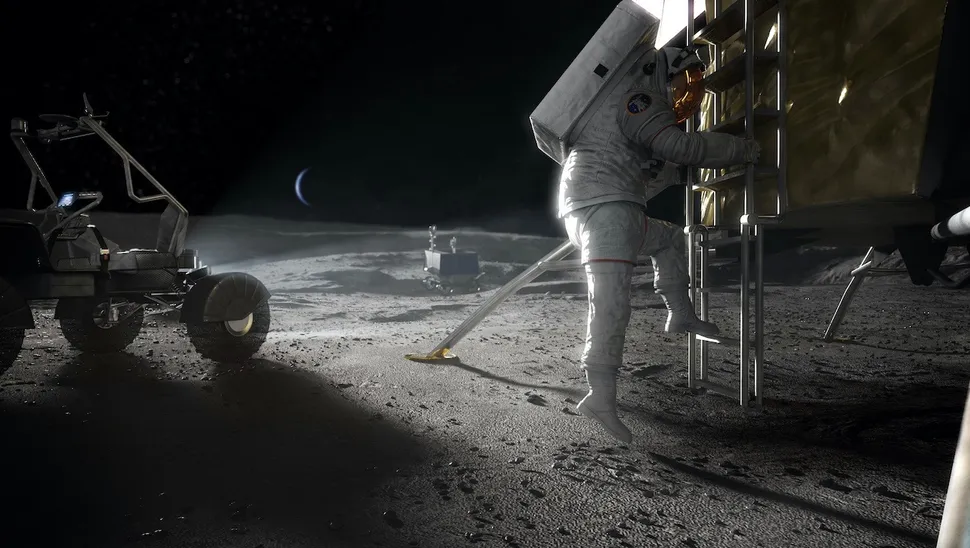Multiple private spacecraft will be ferrying NASA astronauts to the surface of the moon just a few years from now, if all goes according to plan.
In April 2021, NASA picked SpaceX to
build the first crewed lunar lander for the agency's Artemis program,
which is working to put astronauts on the moon in the mid-2020s and establish a
sustainable human presence on and around Earth's nearest neighbor by the end of
the decade.
But SpaceX apparently
won't have the moon-landing market cornered: NASA announced today (March 23)
that it plans to support the development of a second privately built crewed
lunar lander.
"This strategy expedites progress toward a long-term, sustaining lander capability as early as the 2026 or 2027 timeframe," Lisa Watson-Morgan, program manager for the Human Landing System Program at NASA's Marshall Space Flight Center in Alabama, said in a statement today.
"We expect to have two
companies safely carry astronauts in their landers to the surface of the moon
under NASA's guidance before we ask for services, which could result in
multiple experienced providers in the market," Watson-Morgan added.
This new plan isn't all that new,
however. NASA originally intended to select multiple private crewed landers for
Artemis, to have redundancy in place and to drive the teams building the
vehicles through competition. But Congress didn't allocate enough funding to
support the development of multiple vehicles, so NASA went solely with SpaceX
in April 2021.
That decision spurred protests
from the other two finalists for the award, Dynetics and Jeff Bezos' Blue
Origin. Along with a public letter from Bezos to NASA Administrator Bill Nelson
criticizing the decision, Blue Origin filed a lawsuit, which ultimately
failed but held up SpaceX's lander development work for about seven months.
There were even more twists to
come, however. In October 2021, the Senate Appropriations Committee directed
NASA to choose a second company to develop a crewed moon lander. The
funding increase attached to this order was quite small — but NASA apparently
now has assurances that the necessary money will come to support the second
lander.
Congress is "committed to
ensuring that we have more than one lander to choose [from] for future
missions," Nelson said during a news conference today, citing conversations
he's had with people on Capitol Hill over the past year.
"We're expecting to have
both Congress support and that of the Biden administration," Nelson said.
"And we're expecting to get this competition started in the fiscal year
[20]23 budget."
Exact funding amounts and other
details should be coming next week when the White House releases its 2023
federal budget request, he added.
"So what we're doing today
is a bit of a preview," Nelson said. "I think you'll find it's an
indication that there are good things to come for this agency and, if we're
right, good things to come for all of humanity."
NASA plans to release a draft
request for proposals (RFP) for the second moon lander by the end of the month
and a final RFP later this spring, agency officials said. If all goes according
to plan, NASA will pick the builder of the new vehicle in early 2023. That
craft will have the ability to dock with Gateway, the small moon-orbiting
space station that NASA plans to build, and take people and scientific gear
from there to the surface (and back).
This newly announced competition
will be open to all American companies except SpaceX. But Elon Musk's company
will have the opportunity to negotiate the terms of its existing contract to
perform additional lunar development work, NASA officials said during today's
news conference.
SpaceX is scheduled to land NASA's
Artemis 3 mission on the lunar surface in 2025 or 2026 — the first crewed moon
touchdown since Apkollo 17 in 1972. The company will use its huge,
reusable Starship vehicle for the job. (SpaceX also plans to conduct
an uncrewed test flight to the lunar surface with Starship, which is expected
in 2024.) The Artemis 3 plan is unaffected by today's announcement, NASA
officials said.
Artemis hardware goes beyond
Gateway and private landers. The program also depends on a giant new NASA
rocket called the Space Launch System (SLS) and the Orion crew
capsule.
The SLS and Orion that will fly
the Artemis 1 mission just rolled out to the launch pad at NASA's
Kennedy Space Center in Florida last week for testing. Artemis 1, which will
send Orion on an uncrewed journey around the moon, is expected to launch no
earlier than May.

Comments
Post a Comment